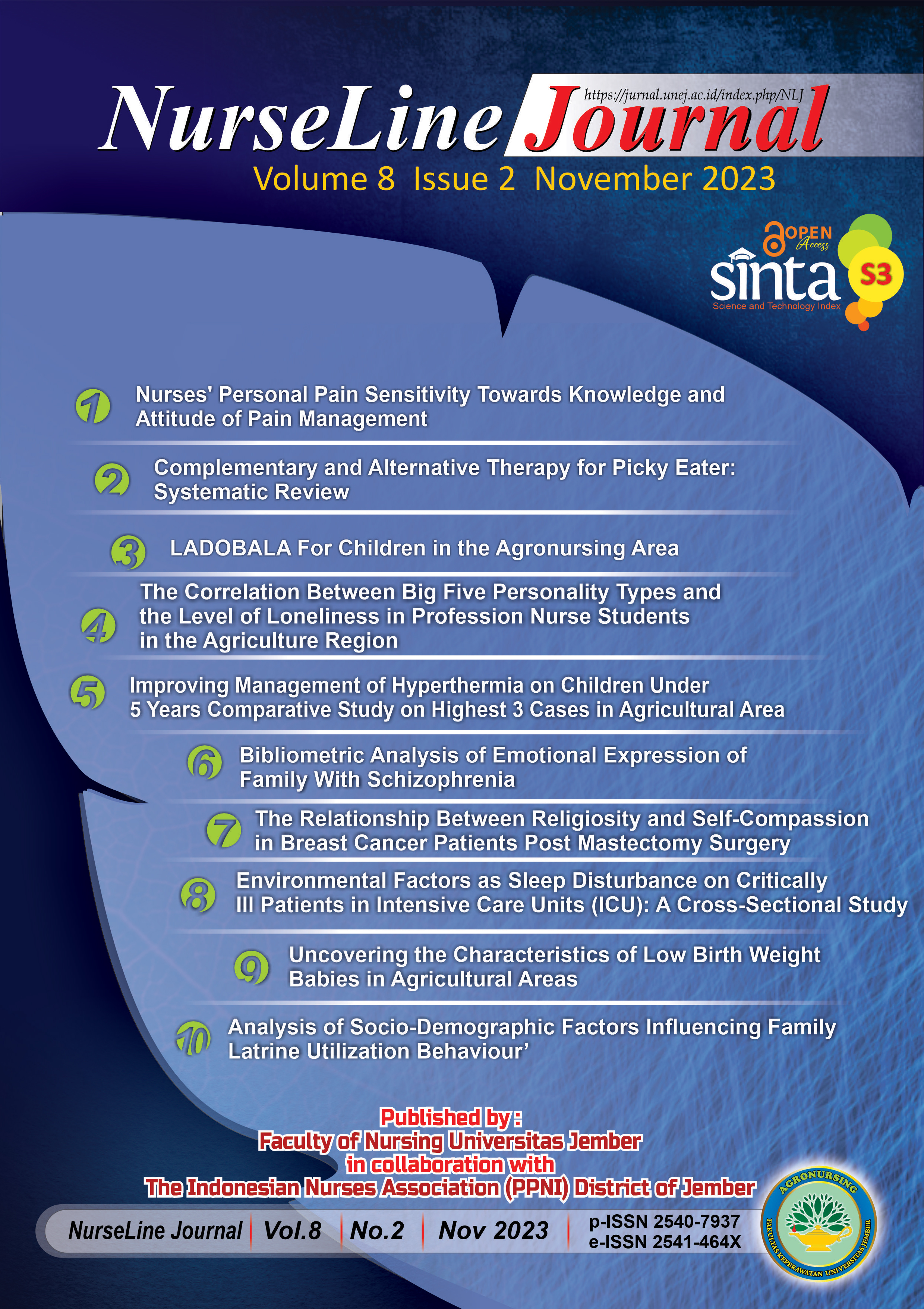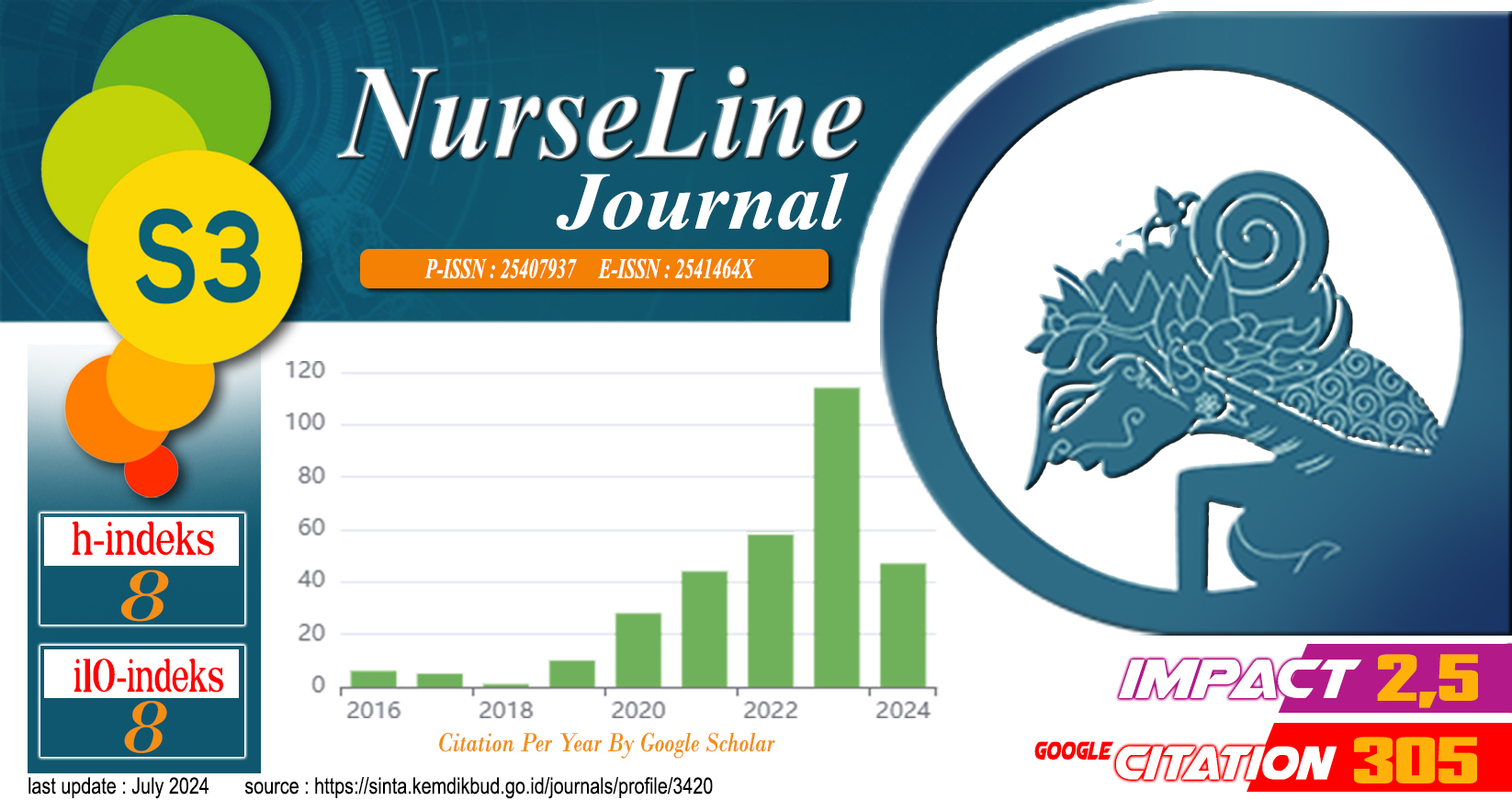Association Between Nurses' Personal Pain Sensitivity Towards Knowledge and Attitude of Pain Management
Abstract
Effective pain management requires the right attitudes, judgments, skills, and knowledge that have an impact on pain treatment outcomes. A careful assessment of each individual’s pain sensitivity is invaluable for the prevention, evaluation, and treatment of pain. This study aimed to determine the relationship of pain sensitivity of professional nurses to pain management knowledge and attitudes. The method used in this research is cross-sectional study with a survey design that provides a quantitative picture of pain sensitivity, knowledge, and attitudes towards pain management in a population, by studying a sample of 160 nurses. Pain Sensitivity Questionnaire (PSQ) and Attitudes of Nurses Regarding Pain. The frequency and percentage of knowledge and attitude regarding pain in category lack (96.87%). Pain sensitivity question score are PSQ Minor score in average value 4.63 and PSQ Moderate score in average score 6.15. There is a significant relationship between attitudes and education with a sig 0.017 (P<0.050. There is a significant relationship between knowledge and attitudes with a sig value of 0.022 (P<0.05), there is no significant relationship between knowledge and pain sensitivity with a sig value 0f 0.689 (p<0.05), there is no significant relationship between attitudes and pain sensitivity with a sig 0.0640 (p<0.05). Efforts to improve knowledge, attitudes, skills and pain sensitivity among healthcare professionals are needed, monitored and evaluated by the hospital administration to improve nurses’ skill in paint management for better patient outcomes
References
Ilmiah Ners Indonesia, 2(2). Available at: https://online-journal.unja.ac.id/JINI/article/view/15455/12122.
Admass, B. A. et al. (2020) ‘Knowledge and attitude of ethiopian oncology nurses about cancer pain management: National survey’, Cancer Management and Research, 12. doi: 10.2147/CMAR.S261172.
Admassu, W. S., Hailekiros, A. G. and Abdissa, Z. D. (2016) ‘Severity and Risk Factors of Post-Operative Pain in University of Gondar Hospital, Northeast Ethiopa’, Journal of Anesthesia & Clinical Research, 7(10). doi: 10.4172/2155-6148.1000675.
Andersson, V. et al. (2017) ‘Pain and pain management in hospitalized patients before and after an intervention’, Scandinavian Journal of Pain, 15. doi: 10.1016/j.sjpain.2016.11.006.
Betancourt, N. T. R. et al. (2014) ‘Factores asociados a presencia de dolor agudo postoperatorio no controlado’, Revista Ciencias Biomédicas, 5(2).
Van Den Beuken-Van Everdingen, M. H. J. et al. (2016) ‘Update on Prevalence of Pain in Patients with Cancer: Systematic Review and Meta-Analysis’, Journal of Pain and Symptom Management. doi: 10.1016/j.jpainsymman.2015.12.340.
Bonkowski, S. L. et al. (2018) ‘Evaluation of a pain management education program and operational guideline on nursing practice, attitudes, and pain management’, Journal of Continuing Education in Nursing, 49(4). doi: 10.3928/00220124-20180320-08.
Brant, J. M. et al. (2017) ‘Nurses’ Knowledge and Attitudes about Pain: Personal and Professional Characteristics and Patient Reported Pain Satisfaction’, Pain Management Nursing, 18(4). doi: 10.1016/j.pmn.2017.04.003.
Bruneau, B. (2014) ‘Barriers to the management of pain in dementia care’, Nursing Times, 110(28).
Burns, M. and McIlfatrick, S. (2015) ‘Palliative care in dementia: Literature review of nurses’ knowledge and attitudes towards pain assessment’, International Journal of Palliative Nursing, 21(8). doi: 10.12968/ijpn.2015.21.8.400.
Chatchumni, M. et al. (2016) ‘Thai Nurses’ experiences of post-operative pain assessment and its’ influence on pain management decisions’, BMC Nursing, 15(1). doi: 10.1186/s12912-016-0136-8.
Chou, R. et al. (2016) ‘Guidelines on the Management of Postoperative Pain Management’, Journal of Pain, 17(2).
Christie, O., Oluseyi, A. and Olufunke, O. (2018) ‘Factors Associated with Utilization of Pain Assessment Tools in Pain Management among Nurses in Selected Hospitals in Ekiti State’, International Journal of Caring Sciences, 11(1).
Cohen, S. P. et al. (2020) ‘Pain management best practices from multispecialty organizations during the COVID-19 pandemic and public health crises’, Pain Medicine (United States), 21(7). doi: 10.1093/pm/pnaa127.
Crawford, C. L. et al. (2016) ‘An integrative review of pain resource nurse programs’, Critical Care Nursing Quarterly. doi: 10.1097/CNQ.0000000000000101.
van Dijk, J. F. M. et al. (2017) ‘Postoperative pain: knowledge and beliefs of patients and nurses’, Journal of Clinical Nursing, 26(21–22). doi: 10.1111/jocn.13714.
Duivenvoorden, T. et al. (2013) ‘Anxiety and depressive symptoms before and after total hip and knee arthroplasty: A prospective multicentre study’, Osteoarthritis and Cartilage, 21(12). doi: 10.1016/j.joca.2013.08.022.
El-Aqoul, A. et al. (2020) ‘Effectiveness of Education Program on Nursing Knowledge and Attitude toward Pain Management’, Asia-Pacific Journal of Oncology Nursing, 7(4). doi: 10.4103/apjon.apjon_17_20.
Fallatah, S. M. A. (2017) ‘Pain Knowledge and Attitude Survey among Health-care Professionals at a University Hospital in Saudi Arabia’, Saudi Journal of Medicine & Medical Sciences, 5(2).
Gan, T. J. et al. (2014) ‘Incidence, patient satisfaction, and perceptions of post-surgical pain: Results from a US national survey’, Current Medical Research and Opinion. doi: 10.1185/03007995.2013.860019.
Gan, T. J. (2017) ‘Poorly controlled postoperative pain: Prevalence, consequences, and prevention’, Journal of Pain Research. doi: 10.2147/JPR.S144066.
Gerrits, M. M. J. G. et al. (2014) ‘Pain and the onset of depressive and anxiety disorders’, Pain, 155(1). doi: 10.1016/j.pain.2013.09.005.
Glare, P., Aubrey, K. R. and Myles, P. S. (2019) ‘Transition from acute to chronic pain after surgery’, The Lancet. doi: 10.1016/S0140-6736(19)30352-6.
Iklima, N., Tania, M. and Destian, S. (2022) ‘Knowledge of Nurses in the Intensive Care Unit About Pain Management’, KnE Medicine. doi: 10.18502/kme.v2i2.11100.
Inoue, S. et al. (2015) ‘Chronic pain in the Japanese community - Prevalence, characteristics and impact on quality of life’, PLoS ONE, 10(6). doi: 10.1371/journal.pone.0129262.
Jayakar, S. et al. (2021) ‘Developing nociceptor-selective treatments for acute and chronic pain’, Science Translational Medicine. doi: 10.1126/scitranslmed.abj9837.
Kahsay, D. T. and Pitkäjärvi, M. (2019) ‘Emergency nurses´ knowledge, attitude and perceived barriers regarding pain Management in Resource-Limited Settings: Cross-sectional study’, BMC Nursing, 18(1). doi: 10.1186/s12912-019-0380-9.
Kizza, I. B. et al. (2016) ‘Nurses’ knowledge of the principles of acute pain assessment in critically ill adult patients who are able to self-report’, International Journal of Africa Nursing Sciences, 4. doi: 10.1016/j.ijans.2016.02.001.
Kolobe, L. E. (2015) Perceptions of Surgical Nurses Regarding the Post-operative Pain Management of Patients After Total Hip or Knee Replacement Surgery. University of South Africa.
Kurniasih, E., Ekayamti, E. and Keperawatan Pemerintah Kabupaten Ngawi, A. (2021) ‘TERAPI NON FARMAKOLOGI SEBAGAI BENTUK SWAMEDIKASI LANSIA DALAM MANAJEMEN NYERI OSTEOARTRITIS’, Jurnal Pengabdian Masyarakat Kesehatan, 7(2), pp. 119–126.
Lauriola, M. et al. (2019) ‘A correlational analysis of the relationships among intolerance of uncertainty, anxiety sensitivity, subjective sleep quality, and insomnia symptoms’, International Journal of Environmental Research and Public Health, 16(18). doi: 10.3390/ijerph16183253.
Lulie, E., Berhanu, M. and Kassa, S. F. (2022) ‘Knowledge, attitude, and associated factors toward pediatric pain management among nurses at the University of Gondar Comprehensive Specialized Hospital: A cross-sectional study’, SAGE Open Medicine, 10. doi: 10.1177/20503121221075163.
Madenski, A. D. (2014) ‘Improving Nurses’ Pain Management in the Post Anesthesia Care Unit (PACU)’, Doctor of Nursing Practice (DNP) Projects.
Maribbay, G. M. L. et al. (2022) ‘Nurses’ Knowledge, Attitudes, and Barriers Toward Pain Assessment and Management in Assir Region, Saudi Arabia’, Journal of Holistic Nursing. doi: 10.1177/08980101221076677.
Masigati, H. G. and Chilonga, K. S. (2014) ‘Postoperative pain management outcomes among adults treated at a tertiary hospital in Moshi, Tanzania’, Tanzania Journal of Health Research, 16(1). doi: 10.4314/thrb.v16i1.7.
Mediani, H. S. et al. (2017) ‘An exploration of Indonesian nurses’ perceptions of barriers to paediatric pain management’, Journal of Child Health Care, 21(3). doi: 10.1177/1367493517715146.
Meissner, W. et al. (2015) ‘Improving the management of post-operative acute pain: Priorities for change’, Current Medical Research and Opinion. doi: 10.1185/03007995.2015.1092122.
Menlah, A. et al. (2018) ‘Knowledge, Attitudes, and Practices of Postoperative Pain Management by Nurses in Selected District Hospitals in Ghana’, SAGE Open Nursing, 4. doi: 10.1177/2377960818790383.
Nahin, R. L. (2015) ‘Estimates of Pain Prevalence and Severity in Adults: United States, 2012’, The Journal of Pain, 16(8), pp. 769–780.
Nguyen, A. T. et al. (2021) ‘Assessing knowledge and attitudes regarding pain management among nurses working in a geriatric hospital in Vietnam’, Journal of Multidisciplinary Healthcare, 14. doi: 10.2147/JMDH.S285044.
Nimer, A. and Ghrayeb, F. A. W. (2017) ‘Palestinian Nurses Knowledge and Attitudes Regarding Pain Management’, International Journal of Scientific and Research Publication, 7(3).
Odunayo, O. F. and Olalekan, P. R. (2020) ‘Knowledge As Predictors of Nurses Attitude Towards Effective Pain Management in Selected Secondary Hospitals in Ibadan, Oyo State, Nigeria’, African Journal of Health, Nursing and Midwifery, 3(1), pp. 53–66.
Paice, J. A. (2018) ‘Cancer pain management and the opioid crisis in America: How to preserve hard-earned gains in improving the quality of cancer pain management’, Cancer. doi: 10.1002/cncr.31303.
Pakarinen, M. et al. (2014) ‘Depressive burden is associated with a poorer surgical outcome among lumbar spinal stenosis patients: A 5-year follow-up study’, Spine Journal, 14(10). doi: 10.1016/j.spinee.2014.01.047.
Price, T. J. and Ray, P. R. (2019) ‘Recent advances toward understanding the mysteries of the acute to chronic pain transition’, Current Opinion in Physiology. doi: 10.1016/j.cophys.2019.05.015.
Quintão, N. L. M. et al. (2019) ‘Pharmacological treatment of chemotherapy-induced neuropathic pain: PPARγ agonists as a promising tool’, Frontiers in Neuroscience. doi: 10.3389/fnins.2019.00907.
Rasmi Issa, M., Awaje H, A. M. and Khraisat, F. S. (2017) ‘Knowledge and Attitude about Pain and Pain Management among Critical Care Nurses in a Tertiary Hospital’, Journal of Intensive and Critical Care, 03(01). doi: 10.21767/2471-8505.100071.
Samarkandi, O. A. (2018) ‘Knowledge and attitudes of nurses toward pain management’, Saudi Journal of Anaesthesia, 12(2). doi: 10.4103/sja.SJA_587_17.
Schmidt, B. L. (2015) ‘What Pain Tells Us About Cancer’, Pain, 156(Suppl 1), p. S32.
Sellers, A. B. et al. (2013) ‘Validation of the english language pain sensitivity questionnaire’, Regional Anesthesia and Pain Medicine, 38(6). doi: 10.1097/AAP.0000000000000007.
Shoqirat, N. et al. (2019) ‘Nurses’ Knowledge, Attitudes, and Barriers Toward Pain Management Among Postoperative Patients in Jordan’, Journal of Perianesthesia Nursing, 34(2). doi: 10.1016/j.jopan.2018.05.012.
Sivertsen, B. et al. (2015) ‘Sleep and pain sensitivity in adults’, Pain, 156(8). doi: 10.1097/j.pain.0000000000000131.
Smeland, A. H. et al. (2018) ‘Nurses’ Knowledge, Attitudes and Clinical Practice in Pediatric Postoperative Pain Management’, Pain Management Nursing, 19(6). doi: 10.1016/j.pmn.2018.04.006.
Sugianti, T. and Joeliatin, J. (2019) ‘Efektifitas Manajemen Nyeri Dengan Kompres dan Relaksasi Genggam Jari Terhadap Nyeri Saat Persalinan Kala I Fase Aktif (Studi Kasus di Wilayah Kerja Puskesmas Kertosono Kabupaten Nganjuk Tahun 2019)’, Jurnal Kesehatan, 7(2). doi: 10.25047/j-kes.v7i2.91.
Tesarz, J. et al. (2013) ‘Alterations in endogenous pain modulation in endurance athletes: An experimental study using quantitative sensory testing and the cold-pressor task’, Pain, 154(7). doi: 10.1016/j.pain.2013.03.014.
The World Bank (2017) World Development Indicators, Indonesia Total Population, The World Bank.
Toba, H. A., Samara, A. M. and Zyoud, S. H. (2019) ‘Nurses’ knowledge, perceived barriers, and practices regarding cancer pain management: A cross-sectional study from Palestine’, BMC Medical Education, 19(1). doi: 10.1186/s12909-019-1613-z.
Tomaszek, L. et al. (2019) ‘Ropivacaine/Fentanyl vs. Bupivacaine/Fentanyl for Pain Control in Children after Thoracic Surgery: A Randomized Study’, Pain Management Nursing, 20(4). doi: 10.1016/j.pmn.2019.02.007.
Tsatali, M. et al. (2014) ‘Depression and Anxiety Levels Increase Chronic Musculoskeletal Pain in Patients with Alzheimer’s Disease’, Current Alzheimer Research, 11(6), pp. 574–579.
Vellucci, R. et al. (2018) ‘Understanding osteoporotic pain and its pharmacological treatment’, Osteoporosis International. doi: 10.1007/s00198-018-4476-y.
Wengström, Y. et al. (2014) ‘The management of breakthrough cancer pain - educational needs a European nursing survey’, European Journal of Cancer Care, 23(1). doi: 10.1111/ecc.12118.
WHO (2018a) Global Cancer Observatory: Indonesia fact Sheets, International Agency for Research on Cancer. Available at: https://gco.iarc.fr/today/data/factsheets/populations/360-indonesia-fact-sheets.pdf (Accessed: 28 March 2023).
WHO (2018b) The Global Health Observatory, World Health Organization.
Williams Amanda C.de and Craig Kenneth D. (2016) ‘Updating the definition of pain’, Pain, 157(11), pp. 2420–2424. Available at: http://ovidsp.tx.ovid.com.ezproxy.is.ed.ac.uk/sp-3.27.1a/ovidweb.cgi?
WebLinkFrameset=1&S=JCBNFPLDOPDDOOGMNCFKDEIBDGOAAA00&returnUrl=ovidweb.cgi%3F%26Full%2BText%3DL%257cS.sh.27.28%257c0%257c00006396-201611000-00006%26S%3DJCBNFPLDOPDDOOGMNCFKDEIBDGOAAA00&d.
Woldehaimanot, T. E., Eshetie, T. C. and Kerie, M. W. (2014) ‘Postoperative pain management among surgically treated patients in an Ethiopian hospital’, PLoS ONE, 9(7). doi: 10.1371/journal.pone.0102835.

This work is licensed under a Creative Commons Attribution-ShareAlike 4.0 International License.
















